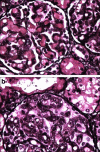Renal thrombotic microangiopathy in patients with cblC defect: review of an under-recognized entity
- PMID: 27289364
- PMCID: PMC5368212
- DOI: 10.1007/s00467-016-3399-0
Renal thrombotic microangiopathy in patients with cblC defect: review of an under-recognized entity
Abstract
Methylmalonic aciduria and homocystinuria, cobalamin C (cblC) type, is the most common genetic type of functional cobalamin (vitamin B12) deficiency. This metabolic disease is characterized by marked heterogeneity of neurocognitive disease (microcephaly, seizures, developmental delay, ataxia, hypotonia) and variable extracentral nervous system involvement (failure to thrive, cardiovascular, renal, ocular) manifesting predominantly early in life, sometimes during gestation. To enhance awareness and understanding of renal disease associated with cblC defect, we studied biochemical, genetic, clinical, and histopathological data from 36 patients. Consistent clinical chemistry features of renal disease were intravascular hemolysis, hematuria, and proteinuria in all patients, with nephrotic-range proteinuria observed in three. Renal function ranged from normal to renal failure, with eight patients requiring (intermittent) dialysis. Two thirds were diagnosed with atypical (diarrhea-negative) hemolytic uremic syndrome (HUS). Renal histopathology analyses of biopsy samples from 16 patients revealed glomerular lesions typical of thrombotic microangiopathy (TMA). Treatment with hydroxycobalamin improved renal function in the majority, including three in whom dialysis could be withdrawn. Neurological sequelae were observed in 44 % and cardiopulmonary involvement in 39 % of patients, with half of the latter group demonstrating pulmonary hypertension. Mortality reached 100 % in untreated patients and 79 and 56 % in those with cardiopulmonary or neurological involvement, respectively. In all patients presenting with unclear intravascular hemolysis, hematuria, and proteinuria, cblC defect should be ruled out by determination of blood/plasma homocysteine levels and/or genetic testing, irrespective of actual renal function and neurological status, to ensure timely diagnosis and treatment.
Keywords: Atypical hemolytic uremic syndrome; Children; Cobalamin C defect; Pulmonary arterial hypertension.
Conflict of interest statement
The authors declare no conflict interest.
Figures



Similar articles
-
Combined pulmonary hypertension and renal thrombotic microangiopathy in cobalamin C deficiency.Pediatrics. 2013 Aug;132(2):e540-4. doi: 10.1542/peds.2012-2581. Epub 2013 Jul 8. Pediatrics. 2013. PMID: 23837176
-
Nephrotic syndrome and thrombotic microangiopathy caused by cobalamin C deficiency.Pediatr Nephrol. 2015 Jul;30(7):1203-6. doi: 10.1007/s00467-015-3110-x. Epub 2015 Apr 18. Pediatr Nephrol. 2015. PMID: 25894566
-
Late-onset renal TMA and tubular injury in cobalamin C disease: a report of three cases and literature review.BMC Nephrol. 2024 Oct 10;25(1):340. doi: 10.1186/s12882-024-03774-w. BMC Nephrol. 2024. PMID: 39390411 Free PMC article. Review.
-
Cobalamin disorder Cbl-C presenting with late-onset thrombotic microangiopathy.Am J Med Genet. 2002 Aug 1;111(2):195-201. doi: 10.1002/ajmg.10499. Am J Med Genet. 2002. PMID: 12210350
-
Syndromes of Thrombotic Microangiopathy.Med Clin North Am. 2017 Mar;101(2):395-415. doi: 10.1016/j.mcna.2016.09.010. Epub 2016 Dec 27. Med Clin North Am. 2017. PMID: 28189178 Review.
Cited by
-
Thrombotic microangiopathy associated with Mycoplasma pneumoniae infection.BMJ Case Rep. 2018 Mar 17;2018:bcr2017222582. doi: 10.1136/bcr-2017-222582. BMJ Case Rep. 2018. PMID: 29550758 Free PMC article.
-
Metabolic and genetic assessments interpret unexplained aggressive pulmonary hypertension induced by methylmalonic acidemia: A case report.World J Clin Cases. 2020 Mar 26;8(6):1137-1141. doi: 10.12998/wjcc.v8.i6.1137. World J Clin Cases. 2020. PMID: 32258084 Free PMC article.
-
The roles of homocysteinemia and methylmalonic acidemia in kidney injury in atypical hemolytic uremic syndrome caused by cobalamin C deficiency.Pediatr Nephrol. 2022 Jun;37(6):1415-1418. doi: 10.1007/s00467-021-05372-6. Epub 2021 Dec 2. Pediatr Nephrol. 2022. PMID: 34854955 Free PMC article.
-
Diseases of complement dysregulation-an overview.Semin Immunopathol. 2018 Jan;40(1):49-64. doi: 10.1007/s00281-017-0663-8. Epub 2018 Jan 11. Semin Immunopathol. 2018. PMID: 29327071 Free PMC article. Review.
-
Thrombotic Microangiopathy and the Kidney.Clin J Am Soc Nephrol. 2018 Feb 7;13(2):300-317. doi: 10.2215/CJN.00620117. Epub 2017 Oct 17. Clin J Am Soc Nephrol. 2018. PMID: 29042465 Free PMC article. Review.
References
Publication types
MeSH terms
Substances
LinkOut - more resources
Full Text Sources
Other Literature Sources

